Invasion of the Soviet Union
The 1 SS Infantry Brigade (mot) was formed on 21 April 1941, from men of the SS-Totenkopfverbände (concentration camp guards). It received the designation of the 1st SS Infantry Brigade (motorised) on 20 September 1941.
When Germany invaded the Soviet Union (Operation Barbarossa) in June 1941, the brigade was stationed in Kraków, Poland awaiting its full complement of men and materials. On 23 July the unit moved east into the occupied territories and between July and August 1941, mopping up dispersed Red Army units in the rear of Army Group South. On 9 August, the brigade was north of Zhitomir and was asked to cover the northern flank of the 6th Army in the Pinsk Marshes. The brigade next operated behind the XVII Army Corps and on 23 August, crossed the Dnieper River.
During the remainder of the year and until late 1942 the unit was assigned to the Reich Security Main Office, which also had the SS Cavalry Brigade and the 2nd SS Infantry Brigade under command. [1] In the autumn of 1941, the brigade actively took part in The Holocaust as part of Einsatzgruppe C and took part in the liquidation of the Jewish population of the Soviet Union, forming firing parties when required. The three brigades were responsible for the murder of tens of thousands of the population by the end of 1941, and they destroyed at least one village st Białystok for no apparent reason as they had not been engaged from it. [1]
On 12 December 1941, the brigade was placed under the command of the 56th Infantry Division on the orders of Army Group Center when a gap appeared in the front line of the 2nd Army in the area of Tula, Yelets Liwny. On 28 December 1941, the unit was placed under the command of LV Army Corps.
1942
The brigade spent the winter in fighting defensive battles in the front line, then received new orders. They were again to form a rear-area security unit. From January to August they took part in security and defensive duties around the area of Kursk and a new commander, Karl Fischer von Treuenfeld, arrived in July. The unit remained in the Kursk area until 11 August when it was sent to the Minsk area. [2]
On 11 October, the brigade was in the Wydriza sector in Central Russia (where Erich von dem Bach-Zelewsky was the SS and Police Leader). It took part in the Operation Karlsbad (11 September to 23 October); also participating were the SS-Sturmbrigade Dirlewanger, SS Schuma Battalion 255 and the 1st Battalion, Légion des Volontaires Français. [2] By the end of it the brigade had recorded the killing of 1051 civilians and alleged partisans for the loss of 24 dead and 65 wounded. [2]
The brigade next took part in the Operation Freda (5 to 9 November), together with the SS-Sturmbrigade Dirlewanger near Borissov. The reported casualties from the operation were light with 2 men killed and 10 missing compared to several hundred dead "partisans", most likely civilians.
The unit was next used in another security action, Operation Nürnberg (19 to 25 November), with Police Kampfgruppe von Gottberg. The operation took place between Gleboki and Wilna. The operation was under the command of Brigadeführer Curt von Gottberg with SS Polizei Regiment 14, two Schuma battalions and a town Gendarmerie unit in support of the 1 SS Infantry Brigade. The operation resulted in 2984 Russian casualties and the release of some German prisoners. At the end of 1942 they were involved in the Battle of Velikiye Luki when the Soviet forces encircled the town of Velikiye Luki. The 83rd Infantry Division which was trapped in the pocket and was destroyed. The 1 SS Infantry Brigade, along with Frikorps Danmark, who had participated in the attempts to break the encirclement under Kampfgruppe Chevallerie had suffered heavy casualties in the process. [2]
War crimes
The brigade took an active part in the killing of the Jewish population assisting the Einsatzgruppen, in the town of Ushomir where it took part in the killing of all male Jews. [2]
Untersturmführer Max Täubner commanded a workshop detail in the brigade and was tried by an SS court in May 1943, along with four other Waffen-SS men, for unauthorized and sadistic killings of a large number of Jews in 1941 and for taking photos of the killings showing them to wife and friends. In the indictment, the SS court states "The accused allowed his men to act with such vicious brutality that they conducted themselves under his command like a savage horde".
The case against four other defendants under Täubner's command was dismissed by the judge Standartenführer Dr. Reinecke. The photos and negatives were later ordered to be destroyed. [3]
Täubner, who had been given a sentence of 10 years, was pardoned in January 1945 and released from prison. [4]
In another version of this trial [5] Taubner was convicted of disregarding secrecy provisions surrounding the exterminations, expelled from the SS, deprived of his civil rights and sentenced to ten years imprisonment, for behavior that was "unworthy of an honorable and decent German man."
Vasyl Valdeman, a Jewish resident of Ostroh reported: "We knew something would be done to us here. When we saw people hit and driven along here with spades, even small children realised why people were carrying the spades."
One of the members of the 1st SS Infantry Brigade at the time was Hans Friedrich. He claims not to recall exactly which actions he took part in that summer, but he does admit to participating in killings like the one in Ostrog. "They were so utterly shocked and timid, you could do with them what you wanted.'"
Vasyl Valdeman: "Kids were crying, the sick were crying, the elderly were praying to God. Not on their knees but seated or lying down. It was very tough to go through it all, hearing all this wailing and crying. Then they had everyone get up and said 'Go', and as soon as people started moving, they selected people for shooting, for execution."
The selected Ukrainian Jews were taken out to this spot and a pit was dug. In scenes which were repeated right across the areas of the Soviet Union occupied by the Nazis, men, women and children were ordered to strip and prepare to die. The killings went on into the evening. Vasyl Valdeman and his mother managed to escape and hide in a nearby village. But the SS killed his father, grandfather and two uncles.
Vasyl Valdeman: "That's how it was—the first execution—the most horrible one. It wasn't the last one. There were three more large executions after that with 2000 to 3000 people shot at every one of them. More people were executed afterwards in smaller scale ones and this is how the Jewish community of Ostrog was annihilated." [6]

The Waffen-SS was the combat branch of the Nazi Party's paramilitary Schutzstaffel (SS) organisation. Its formations included men from Nazi Germany, along with volunteers and conscripts from both German-occupied Europe and unoccupied lands. It was disbanded in May 1945.
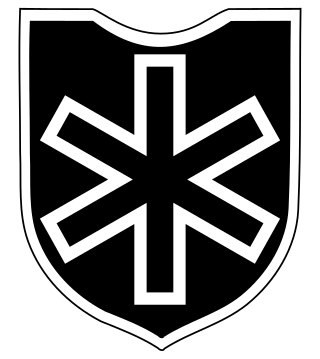
The 6th SS Mountain Division Nord was a World War II mountain infantry division of the Waffen-SS, the military wing of the German Nazi Party, primarily consisting of ethnic Germans along with some Norwegian and Swiss volunteers. It was the only Waffen-SS division to operate in the Arctic Circle.

Bronislav Vladislavovich Kaminski was a Nazi collaborator and the commander of the Kaminski Brigade, an anti-partisan and rear-security formation made up of people from the so-called Lokot Autonomy territory (1941-1943) in part of the German-occupied area of the Soviet Union. The Kaminski Brigade later became part of the Waffen-SS as the SS Sturmbrigade RONA. Under Kaminski's command, the unit committed numerous war crimes and atrocities in the German-occupied Soviet Union and in Poland.

The 1st SS Panzer Division Leibstandarte SS Adolf Hitler or SS Division Leibstandarte, abbreviated as LSSAH, began as Adolf Hitler's personal bodyguard unit, responsible for guarding the Führer's person, offices, and residences. Initially the size of a regiment, the LSSAH eventually grew into an elite division-sized unit during World War II.
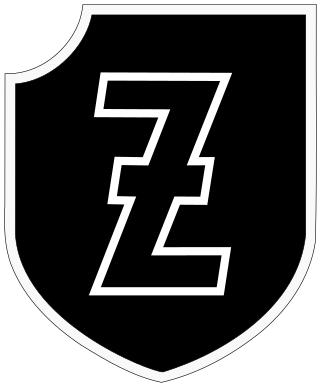
The 4th SS Polizei Panzergrenadier Division or SS Division Polizei was one of the thirty-eight divisions fielded as part of the Waffen-SS during World War II.
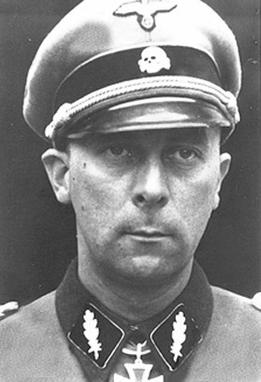
Wilhelm Mohnke was a German military officer who was one of the original members of the SchutzstaffelSS-Stabswache Berlin formed in March 1933. Mohnke, who had joined the Nazi Party in September 1931, rose through the ranks to become one of Adolf Hitler's last remaining general officers at the end of World War II in Europe.

The 5th SS Panzer Division Wiking or SS Division Wiking was an infantry and later an armoured division among the thirty-eight Waffen-SS divisions of Nazi Germany. During World War II, the division served on the Eastern Front. It surrendered on 9 May 1945 to the American forces in Austria.
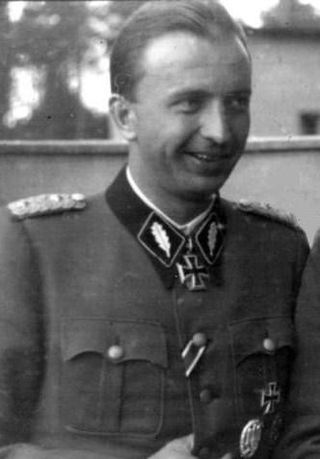
Hans Otto Georg Hermann Fegelein was a high-ranking commander in the Waffen-SS of Nazi Germany. He was a member of Adolf Hitler's entourage and brother-in-law to Eva Braun through his marriage to her sister Gretl.

The Volunteer Legion Netherlands was a collaborationist military formation recruited in the German-occupied Netherlands during World War II. It was formed in the aftermath of the German invasion of the Soviet Union and fought on the Eastern Front in the Waffen SS alongside similar formations from other parts of German-occupied Western Europe. It was the largest Dutch SS unit.

The 20th Waffen Grenadier Division of the SS was a foreign infantry division of the Waffen-SS that served alongside but was never formally part of the Wehrmacht during World War II. According to some sources, the division was under Reichsführer-SS Heinrich Himmler's overall command but was not an integral part of the Schutzstaffel (SS). It was officially activated on 24 January 1944, and many of its soldiers had been members of the Estonian Legion and/or the 3rd Estonian SS Volunteer Brigade, which had been fighting as part of German forces since August 1942 and October 1943 respectively. Both of the preceding formations drew their personnel from German-occupied Estonia. Shortly after its official activation, widespread conscription within Estonia was announced by the German occupying authorities. The division was formed in Estonia around a cadre comprising the 3rd Estonian SS Volunteer Brigade, and was initially known as the 20th Estonian SS Volunteer Division.

The 14th Waffen Grenadier Division of the SS , commonly referred to as the Galicia Division, was a World War II infantry division of the Waffen-SS, the military wing of the German Nazi Party, made up predominantly of volunteers with a Ukrainian ethnic background from the area of Galicia, later also with some Slovaks.

Kaminski Brigade, also known as Waffen-Sturm-Brigade RONA, was a collaborationist formation composed of Russian nationals from the territory of the Lokot Autonomy in Axis-occupied areas of the RSFSR, Soviet Union on the Eastern Front.
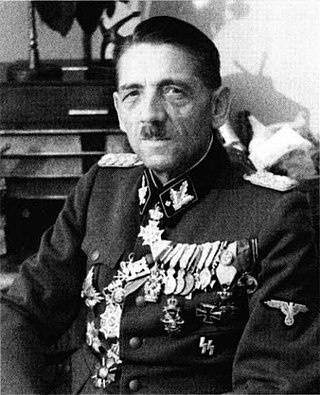
Artur Gustav Martin Phleps was an Austro-Hungarian, Romanian and German army officer who held the rank of SS-Obergruppenführer und General der Waffen-SS in the Waffen-SS during World War II. At the post-war Nuremberg trials, the Waffen-SS – of which Phleps was a senior officer – was declared to be a criminal organisation due to its major involvement in war crimes and crimes against humanity. An Austro-Hungarian Army officer before and during World War I, Phleps specialised in mountain warfare and logistics, and had been promoted to Oberstleutnant by the end of the war. During the interwar period he joined the Romanian Army, reaching the rank of General-locotenent, and also became an adviser to King Carol. After he spoke out against the government he was sidelined and asked to be dismissed from the army.

The 29th Waffen Grenadier Division of the SS also Legione SS Italiana was an SS formation of Nazi Germany during World War II. It was originally created in the Italian Social Republic in 1943 as the Italian Legion, later renamed to a brigade. The unit was upgraded to division status on 10 February 1945.

Curt Gustav Friedrich Walther von Gottberg was a high-ranking SS Obergruppenführer who served as Higher SS and Police Leader for central Russia and, from September 1943, as the Generalkommissar (Commissioner-General) of occupied Belarus, combining the highest civil and police powers in that jurisdiction during the Second World War.

Schutzmannschaft-Brigade Siegling was a Belarusian Auxiliary Police brigade formed by Nazi Germany in July 1944 in East Prussia, from six auxiliary police battalions following the Soviet Operation Bagration.
The 2nd SS Infantry Brigade (mot.) was formed on the 15 May 1941, under the command of Karl Fischer von Treuenfeld with the 4th and 5th SS Infantry Regiments and began its operational service in September in the Army Group North Rear Area, under which command it would spend its entire existence. It gradually began to incorporate foreign legions of the SS under its operational control. After the western legions departed for refit, it began operating with Latvian volunteer formations and eventually was redesignated the 2nd Latvian SS Infantry Brigade and on the 18 May 1943, and used as the cadre in the formation of the Waffen Grenadier Division of the SS in January 1944.

Fritz Freitag was a German SS commander during the Nazi era. During World War II, he commanded the 2nd SS Infantry Brigade, the SS Cavalry Division Florian Geyer, and the SS Division Galicia. Freitag committed suicide in May 1945.

The 81st Infantry Division was an infantry division of the German Army during World War II. It was active from 1939 until 1945 and served primarily on the Eastern Front.
József Grassy was a Hungarian military officer in the Royal Hungarian Army who, in the Second World War, commanded Hungarian divisions as an SS-Gruppenführer and Generalleutnant of the Waffen-SS. After the war, he was convicted of war crimes and executed.


















